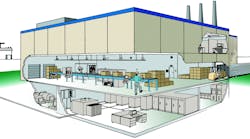Every electrical distributor has a different take on the residential market. Many industrially-oriented distributors don't deal with it. And in many mature suburbs, inner cities or other areas where new residential construction is nonexistent or at a standstill, the residential market may not provide many sales dollars at all. However, in a fast-growing Sunbelt suburb, this could be a key market for a distributor.
What the market is depends on how you define it, too. For a residential lighting specialist that isn't into pipe and wire, the residential market means selling replacement fixtures to homeowners or a “houseful” of fixtures to a new home buyer who has the builder's lighting fixture allowance to spend.
But it's a key market for hundreds of electrical distributors however you slice it. Electrical distributors forecast that this market will account for 19.7 percent ($15 billion) in industry sales in 2002, according to Electrical Wholesaling's 2001 Market Planning Guide. The largest segments of the market include the new construction and renovation of single-family homes and multi-family housing units, such as townhouses and apartment buildings.
The market for residential lighting fixtures sold through full-line electrical distributors, residential lighting specialists, home centers, hardware stores and department stores operates differently than other aspects of the electrical market, primarily because of the retail nature of this business and the fact that the customer is most often a homeowner. Despite massive competition from home centers in this market, distributors expect to sell $2.2 billion (2.9 percent of all sales through electrical distributors) in residential lighting fixtures.
Lighting may be the most visible segment of the residential market, but the wiring system hidden behind the walls of your home generates far more sales for full-line electrical distributors. The key products in this segment of the residential market include service-entrance equipment; load centers; circuit breakers; connectors; fittings and fasteners; building wire and structured cabling systems; service entrance cable; low-voltage wiring for security, sound, intercom, phone and home networking applications; wiring devices; and wall plates. Check out the illustration on the next page for a detailed description of the primary products in the residential market.
To make the most of the residential market, you will need to first understand how the residential market works.
THE CUSTOMER
Distributors work closely with two key customers in this market. For those distributors that focus on new construction and renovation, it's the electrical contractor. Those companies with residential lighting showrooms focus on the homeowner. You also should get to know the builders in your market area. They work on a very tight production schedule, and the more you know about what they expect from their subcontractors, the better off you and your contractor customers will be. Builders also will sometimes buy bulk lighting fixtures and some other electrical products directly from distributors. Let's look at how to build relationships with these customers and buying influences.
Keep your promises. Distributors don't have any great secrets in building relationships with electrical contractors. The biggest factor is, and has always been, service. Sure, contractors probably are more price-conscious than any other customers. And, yes, in the residential market they can get many of the products you sell from home centers. But contractors in your market for the long haul need a dependable source for supplies. They need a distributor who may not always be the cheapest on each and every product, but is the most reliable distributor in town.
As much as and probably more than any other customer, electrical contractors need the electrical distributor to deliver the right products on time and in the right location. Whether that be a delivery to the job site or a pick-up at the counter, the electrical contractor depends on the distributor to come through. That's because contractors are on a tight time schedule at the job site. If they can't finish the wiring, it has a chain-reaction effect, holding up the sheet-rockers, painters, trim carpenters, and so on down the line. If the electrical contractor is gumming up the works on a new home, his boss at the construction site — usually the general contractor or builder — isn't going to be happy with him and may not use him in the next phase of the development. When this happens, you don't need too much imagination to figure out what that contractor will think of the electrical distributor who made him late.
If builders in your market area are offering home-networking systems in their developments, this adds another step in the construction process — and puts additional pressure on the time line. That's why many builders prefer to deal with one electrical contractor (and by extension, a sole source of power and home-networking supplies) to wire traditional wiring and structured cabling systems.
Don't underestimate the power of credit. Why do contractors continue to do business with distributors when they can buy so many of the products they sell from Home Depot and other home centers? Credit is definitely one of the key reasons. Electrical contractors, particularly smaller electrical contractors, value a credit line from a dependable supply source. They need credit to keep working, and those credit lines on Visa, MasterCard or the store credit cards they get at the home centers only go so far.
Sure, contractors can often be a bigger credit risk than other customers. And while every distributor has either heard of or has had personal experience with an unscrupulous contractor running up a credit line and then skipping town, these horror stories are fortunately more the exception rather than the rule. Why do contractors have financial problems? Most often it's because they fall victim to inadequate cash flow, the cyclical nature of the construction market, unscrupulous general contractors or poor business management on their own part.
Small residential contractors can turn into big commercial/industrial contractors. The saying, “From tiny acorns do mighty oaks grow,” applies directly to contractors. That new contractor in town doing a few residential service calls and trying to crack the new construction market may not add much to your company in the way of sales or profits today. But when these companies grow, they often expand past the residential market into the commercial or industrial markets. As they grow, so too does their buying power. They usually remember who did and didn't offer them credit when they were just starting out, or who helped them get their business off the ground.
Teach contractors about business basics. Electrical contractors may be wiring wizards, but they often have trouble running a business. Accounting, bookkeeping and budgeting are usually second-nature to many electrical distributors. But contractors with no business background may struggle with these basic business skills. Have contractors sit down with your financial manager to get some basic business tips. Contractors often have a lot to learn about marketing themselves, too, and if your company has a marketing person on staff, he or she may have advice for customers in this area, too. You should also encourage these customers to join community organizations like the Kiwanis or Chamber of Commerce. This will give them the opportunity to develop professional relationships with accountants, bankers and lawyers that they may someday need to use in their business.
Be prepared to offer some technical help. Although contractors have been pulling building wire for so long they can do it blindfolded, if an unusual installation does come up, they need information from the distributor or the manufacturer's rep on that product. Providing this technical assistance can make the distributor look like a champ.
Get a grip on the technical basics. For salespeople and other employees new to the electrical market, or for those employees not too technically inclined, studying the residential market is helpful because the technical functions of these products are easier to understand than those in the commercial and industrial markets.
The first step in learning more about the fundamentals of electricity is to take a course or read one of the many books published on this subject. Manufacturers or trade associations also often provide training material on this area. The Electrical Products Education Course (EPEC) is a great training program offered by the National Association of Electrical Distributors (NAED), St. Louis. You can find more information on EPEC at www.naed.org.
Once you feel comfortable with electrical theory, the next step is to get a feel for how these fundamentals actually work in an electrical system. Home wiring is a great place to see these fundamentals in action because residential systems use relatively basic electrical circuitry.
Work with builders to alert your contractor customers to opportunities in the home-networking market. As mentioned, home builders are looking for one contractor to handle power wiring and low-voltage structured wiring systems for computers, home entertainment and security systems. If you can supply home-networking supplies along with traditional products, you can increase your sales-per-house.
Use what you learn in the residential market to build sales with other customers. The residential market is important to study because it offers a solid foundation in the customer-service basics that so often determine the distributor of choice in a particular market.
When dealing with homeowners, product knowledge separates distributors from home centers. The rules of the game may be somewhat different in the residential lighting market. But product knowledge is still a key value-added service that distributors can offer, whether they are selling fuses or chandeliers. This is an issue in the residential lighting market because of competition from home centers. It can be tough to compete with home centers on price for many of the basic fixture styles. To survive, many residential lighting distributors have focused on areas where home centers are weak such as the high end of the market, lighting design and on offering knowledgeable sales assistance.
PRODUCTS WITH AN EXTRA EDGE
Many of the electrical products used in residential construction haven't changed much, but over the past few years, several relatively new products designed for the residential business have hit this market. You should make sure that your contractor customers are aware of them. The most popular new products with electrical contractors these days seem to fall in two distinct categories: labor-saving tools that allow them to save time, money and effort on the job site, and products required by federal, state or industry safety regulations. Here are some examples of these products.
Arc-fault circuit interrupters (AFCIs) — To reduce the number of electrical fires caused by parallel arc faults in branch circuit wiring, the National Electrical Code (NEC) 210.12(A) now requires a listed arc-fault circuit interrupter (AFCI) protection device in the branch circuit wiring that services dwelling-unit bedrooms. The AFCI protection device must de-energize and protect the entire circuit from an arc fault, according to Mike Holt, NEC consultant for EC&M and CEE News magazines. The only device that can do this is an AFCI circuit breaker.
Surge suppression equipment — Because so many homes are loaded with sensitive electronic equipment, your customers may be asked to install surge suppression equipment at the service entrance.
Generators and backup power equipment — Homeowners are more conscious about keeping a steady supply of power for their homes, and it's becoming more common for them to install generators or other backup power equipment.
Structured wiring systems — The most exciting new opportunity for your customers in the residential market is the installation of home networking for computers, security and home entertainment applications.
Cable fasteners — NEC Article 300.4(D) requires that building wire be placed 1 1/4-inch from the edge of the stud to protect it from drywall screws or nails.
Metal-stud boxes and bushings — In some other areas of the United States, metal-stud construction has replaced wood studs as the primary frame of the building. This has created new sales opportunities for the bushings required to protect the cable from the sharp edges of the stud and for special boxes for steel-stud construction.
Weatherproof outlet covers — NEC regulation 410.57 requires the use of outlet covers for outside receptacles to protect them from the elements.
GFCI equipment — More areas than ever in the home must now be protected by ground-fault circuit interrupters (GFCIs). These areas include bathrooms, kitchens, basements and outdoor receptacles. Check out the product offerings from manufacturers of wiring devices and GFCI circuit breakers. A related NEC rule now calls for GFCI protection of portable cords, which can be a nice add-on sale.
Safety products — Hard hats, safety goggles and signage are just a few of the many safety products that you can sell to residential electrical contractors.
Dimming products — Dimmers and dimming systems offer the opportunity to sell more than just a wall switch. For instance, contractors can “sell up” on residential service calls to replace a dimmer that's burned out. Some manufacturers provide demonstration dimming systems for contractors to bring out on these service calls.
Top-shelf lighting — With their white, clear light, halogen lamps have become popular for downlights, track lighting and in undercabinet lighting applications for kitchens and home offices.
Snow-melting equipment — A relatively new product that can be sold in upscale residential construction projects in the northern climates, where snow and ice is a problem, is a snow-melting system that can be installed beneath walkways or driveways to keep these areas passable during colder weather.
Labor-saving tools — Electrical distributors have good reasons to carry tools that can time and labor on the job. Contractors have an innate love for tools and are always interested in what's new in this area. Tools are also an excellent product line to merchandise in the counter area because many customers buy them on impulse.
Solid sales opportunities abound in the residential market if you stick to the basics of customer service and explore these hot product areas.
The next installment of this series will cover sales opportunities in the utility market.
Key Sales Opportunities in the Residential Market
- POWER IN
- Pole-line hardware
- Service entrance cable
- Utility meters
- Load centers
- Auxiliary panels
- Circuit breakers
- Connectors
- Panel-mounted surge suppressors
- CURRENT CARRIERS
- Building wire
- Security, coaxial, intercom, phone & computer cabling
- Portable cord
- Wiring devices & wall plates
- GFCI & AFCI wiring devices or circuit breakers
- Occupancy sensors
- Wire connectors
- Surge suppressors
- PROTECT & DIRECT
- Cable fittings
- Cable fasteners
- Nonmetallic & metallic conduit
- Receptacle boxes
- Junction boxes & covers
- Weatherproof covers for outdoor outlets
- LIGHTING LOADS & SUPPLIES
- Outdoor security lighting
- Landscape & outdoor lighting
- Chandeliers
- Recessed & track lighting
- Undercabinet lighting
- Kitchen & dining area lighting
- Bathroom & stairway lighting
- Dimming equipment
- Workshop & garage lighting
- Replacement ballasts
- MISC. ELECTRICAL LOADS
- Electric heaters
- Under-tile heating systems
- Snow-melting equipment for driveways & walkways
- Central vacuum systems
- Ceiling fans
- Ventilating equipment
- Intercom systems & doorbells
- Structured wiring systems
- Smoke & CO2 detectors
IN THE TRUCK
- Fittings, fasteners & connectors
- Cable ties & electrical tape
- Screws, nuts & bolts
- Wire lube
- Wire connectors
- Flashlights & rope
- Hard hats & foul-weather gear
- Work clothing, gloves & boots
- County & state maps
- Water coolers & lunch boxes
TOOLS OF THE TRADE
- Tool belts
- Tool boxes
- Tool buckets
- Metering equipment
- Hammers & saws
- Power drills
- Reciprocating saws
- Measuring tape
- Wire cutters
KEY QUESTIONS
You can service each customer better if you develop an account profile. Here are some key questions that will help you.
- How long has the company been in business?
- How many people does the company employ full-time?
- Is it a family-owned business?
- Is the first generation still active in the business?
- Are any sons or daughters active in the business?
If so, will they take over the business when the father or mother retires? - Is the company union or nonunion?
- On average, how many crews does the company usually have working?
- Who are the key buying influences at the company?
- What are their brand preferences for key residential products?
- What is the customer's primary market focus?
- How would your rate the customer's creditworthiness?
- Where does the customer bank?
- How efficiently does the customer run the business?
- Would he or she benefit from any help in bookkeeping, accounting, project management or marketing?
- Can your company provide help in these areas?








